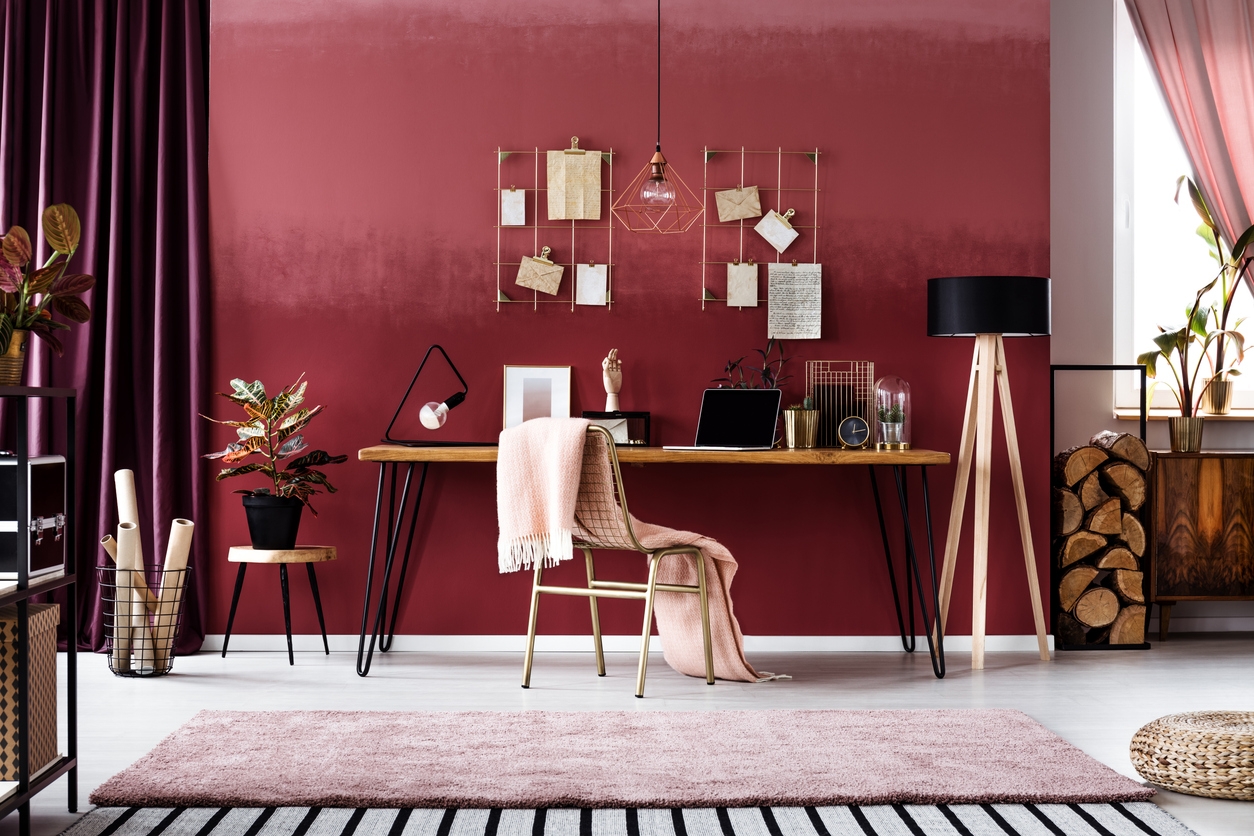Red is probably the color that provokes the strongest response and draws the most attention. If you want to make a statement while decorating a space, you will likely choose red.
Red is a powerful and dynamic color choice usually associated with strong emotions, energy, and passion. It can evoke feelings ranging from warmth and excitement to aggression and urgency.
Understanding red’s impact in various spaces is crucial for harnessing its potential to influence mood, behavior, and perception. Whether used in interior design, branding, or fashion in different shades, red can transform a space by drawing attention, creating a sense of intimacy, or even stimulating action. It’s essential to consider red’s effects when using it for different environments.
Psychological effects of red
Red has powerful psychological effects:
- Emotional and psychological associations: Red is often associated with strong emotions like love, passion, and excitement, as well as anger, danger, and urgency. It can increase heart rates and create a sense of urgency or excitement.
- Influence on mood and behavior: Red can stimulate energy and increase appetite – no wonder restaurants often use this color. It can also heighten alertness and aggression, potentially leading to more impulsive actions.
- Cultural significance: In many cultures, red symbolizes luck, prosperity, and celebration, such as in China. In Western cultures, it’s commonly associated with romance and passion but also warnings and danger.
Red in the living room
Using red in a living room can create a warm and inviting atmosphere, evoking feelings of energy and comfort. Here’s how to incorporate red effectively:
1. Creating a warm and inviting atmosphere: Red is a vibrant color that can make a living room feel cozy and lively. It’s perfect for spaces where you want to encourage social interaction and warmth. Use red on walls, furniture, or decor to create a bold, passionate environment.
2. Tips for using red as an accent or primary color:
- As an accent: If you’re hesitant about using too much red, start with accents. If you’re hesitant about using too much red, start with accents. Go for red throw pillows, rugs, artwork, or curtains. Considering this tip allows you to introduce the color without overwhelming the space.
- As a primary color: For a more dramatic look, paint one wall red or use a red sofa as the focal point. Complement it with softer tones in the rest of the room to keep the balance.
3. Balancing red with neutral tones: Red can be intense, so balancing it with neutral tones like beige, gray, or white helps soften the space. Neutral furniture, walls, or floors paired with red accents can create a harmonious and stylish look. This approach prevents the room from feeling too overwhelming while enjoying the warmth red brings.
Red in the kitchen
Using red in the kitchen can be a dynamic choice that adds warmth and energy to the space. Here’s a brief discussion:
Stimulating appetite and energy
Red is known to stimulate appetite and increase energy levels, making it an excellent choice for kitchens. The vibrant nature of red can create a lively atmosphere, encouraging social interaction and making the kitchen a more inviting space.
Popular red shades for kitchens
- Cherry red has a bright and bold shade that can add a retro or modern flair.
- Brick red has a more subdued, earthy tone, offering a rustic or traditional feel.
- Burgundy is a deep, rich red that adds sophistication and works well in more formal or elegant kitchen designs.
- Tomato red is a vibrant, slightly orange-toned red that feels fresh and contemporary.
Balancing red with other colors
Balance red neutral tones like white, gray, or beige to avoid overwhelming the space. If you want a more dramatic effect, pair red with black – it can create a striking, modern look. But if you prefer a softer appearance, combine red with warm wood tones or muted greens to create a cozy and harmonious environment.
Red in the bedroom
As red is an intense color, it may not be popular for bedrooms. But if used appropriately, red in the bedroom can make a stylish statement while creating a warm, snug atmosphere. Using red thoughtfully can also make your bedroom a perfect blend of restfulness and passion. Here’s how to approach it:
Considerations for creating a restful yet passionate space
- Shade selection: Choose deeper shades like burgundy or wine for a soothing effect, while brighter reds can energize the space.
- Balance: Pair red with softer, neutral tones like beige, cream, or soft grays to prevent it from becoming overwhelming.
- Lighting: Soft, warm lighting can help tone down the intensity of red, making it more calming.
Best ways to incorporate red in bedding, accents, and decor
- Bedding: Use red in your duvet cover, pillows, or throw blankets. Layering different textures can add depth and luxury.
- Accents: Consider red curtains, rugs, or lampshades to introduce pops of color without dominating the space.
- Decor: To tie the room together, incorporate red in wall art, vases, or even a statement chair.
Using red to create a romantic ambiance
- Accent wall: A red accent wall behind the bed can create a focal point and add warmth.
- Candles and soft furnishings: Red candles, plush cushions, and velvet throws can enhance the romantic vibe.
- Flowers: Fresh red roses or other red flowers can add a natural touch of romance.
Red in the home office
Using red in a home office can be a powerful tool for enhancing energy and focus, but it requires careful consideration to avoid overstimulation. Here’s how you can effectively incorporate red into your home office design:
Boosting energy and focus
Red is a stimulating color that can increase alertness and energy levels, making it ideal for environments where focus and productivity are key. By introducing red into your home office, you can create a space that encourages a dynamic work atmosphere. Red can help combat fatigue, especially during long work sessions, by keeping your mind engaged.
Ideas for using red:
- Accent wall: Paint one wall red to create a focal point that energizes the room. This tip works particularly well behind a desk or in a space where you need an energy boost.
- Furniture: Consider red office chairs or a red desk to introduce the color without overwhelming the space.
- Accessories: Use red in smaller doses, such as in desk organizers, lamps, or artwork, to bring energy to the room without being overpowering.
Strategic placement of red to avoid overstimulation
While red can be invigorating, too much of it can lead to feelings of stress or agitation, especially in a space meant for concentration. The key is to use red strategically so that it enhances productivity without becoming a distraction.
Tips for strategic placement:
- Behind you: Place red elements behind where you sit to create a stimulating background that is out of your direct line of sight as you work.
- Out of peripheral vision: Avoid placing red items in your peripheral vision where they might be distracting. Instead, position them in areas where you can engage with the color when you need a boost.
- Subtle details: Incorporate red in subtly, like in the stitching on your chair, the trim on curtains, or small decorative objects. Doing so allows you to benefit from the color’s energy without overwhelming the space.
Complementing red with calming colors for productivity
To balance the intensity of red, pair it with calming colors that promote focus and tranquility. Neutral tones like white, gray, or beige can help temper red vibrancy, while cooler colors like blue or green can create a sense of calm and order.
Color pairing ideas:
- Red and white: A classic combination that keeps the space bright and clean while allowing the red accents to stand out.
- Red and gray: Gray tones down red’s intensity, adding a sophisticated, modern feel to the office.
- Red and blue: Blue is known for its calming properties and can balance red’s energy, making it a good choice for maintaining focus.
- Red and wood tones: Natural wood tones add warmth and balance, grounding the space and softening the impact of red.
Integrating red into your home office thoughtfully lets you create an energizing workspace conducive to productivity. Balancing red with strategic placement and complementary colors will ensure that your office remains a place of focus without becoming overwhelming.
Red in other spaces
Red in bathrooms: bold and contemporary looks
Using red in bathrooms can create a striking, modern aesthetic. Red tiles, walls, or accents can make a small space feel vibrant and energetic while also adding a touch of luxury. Red can turn a bathroom into a bold statement space when paired with sleek fixtures and minimalistic decor.
Red in entryways: making a strong first impression
Red in entryways immediately grabs attention, setting a welcoming yet impactful tone as guests enter your home. A red door, rug, or wall can create a dramatic focal point, leaving a lasting impression and adding warmth and energy to the space.
Red in children’s rooms: playful and stimulating choices
In children’s rooms, red can be a playful and stimulating color that encourages creativity and activity. You can use red on feature walls, furniture, or accessories to create a lively, fun environment. However, balancing red with softer tones is the key to preventing the space from becoming too overwhelming.
Conclusion
Experimenting with red in various spaces throughout your home can lead to stunning and impactful results. Whether you use it as a bold statement or a subtle accent, red’s versatility allows it to adapt to any room, creating atmospheres that range from energizing to cozy, passionate to playful. Don’t be afraid to explore the possibilities that red offers in your décor.
Ready to transform your home with the power of red? Contact Custom Painting, Inc. today to bring your vision to life with professional expertise and exceptional service. To request a free estimate, call us at 925-686-0903 or send a note to us here.



